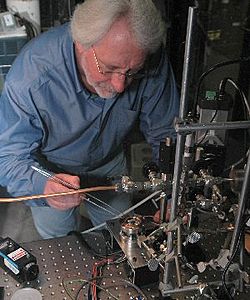Michael McKubre facts for kids
Quick facts for kids
Michael McKubre
|
|
|---|---|

Michael McKubre working on deuterium gas-based cold fusion cell used by SRI International.
|
|
| Born | |
| Alma mater | Victoria University of Wellington |
| Scientific career | |
| Fields | cold fusion |
| Institutions | SRI International |
| Thesis | An Impedance Study of the Membrane Polarisation Effect in Simulated Rock Systems (1976) |
| Doctoral advisor | John Tomlinson |
Michael Charles Harold McKubre is a scientist from New Zealand. He is an electrochemist, which means he studies how electricity and chemical reactions work together. He is well-known for his research into a special type of energy called cold fusion.
For many years, he led the Energy Research Center at SRI International, a big research organization.
Contents
Education and Early Research
Michael McKubre went to Victoria University of Wellington in New Zealand. He earned two important degrees there. In 1972, he got his Master's degree. Later, in 1976, he completed his PhD, which is the highest university degree. His PhD research looked at how electricity moves through rocks.
Career in Cold Fusion
From 1989 to 2002, Michael McKubre worked at SRI International. During this time, he focused on cold fusion research. Unlike many other scientists in this field, he was able to get funding from major organizations. He received support from the Electric Power Research Institute, the Japanese government, and later the U.S. government. This funding helped him continue his important experiments.
Lab Safety and Challenges
In January 1992, an accident happened in an SRI lab where McKubre was working. A cold fusion experiment cell exploded. Sadly, one of his co-workers died, and three people, including McKubre, were hurt. McKubre still has small pieces of glass from the explosion in his side. After this event, all future experiments were done behind strong, bulletproof glass for safety.
Reviewing Cold Fusion Research
In 2004, Michael McKubre and other cold fusion researchers asked the United States Department of Energy (DOE) to look at the field of cold fusion again. They put together a report with all the new experimental information and theories that had been found since 1989.
The DOE reviewed the information. They noted that the tools used to measure energy, called calorimeters, had become much better since 1989. However, their overall conclusion was similar to their earlier review in 1989.
Ongoing Research
As of 2010, Michael McKubre was still doing experiments with special cells made of palladium at SRI International. He also worked with the ENEA laboratory in Italy, which is known for making very reliable palladium materials. More recently, McKubre was part of a group of 22 physicists who reviewed the work of another company called Steorn.

